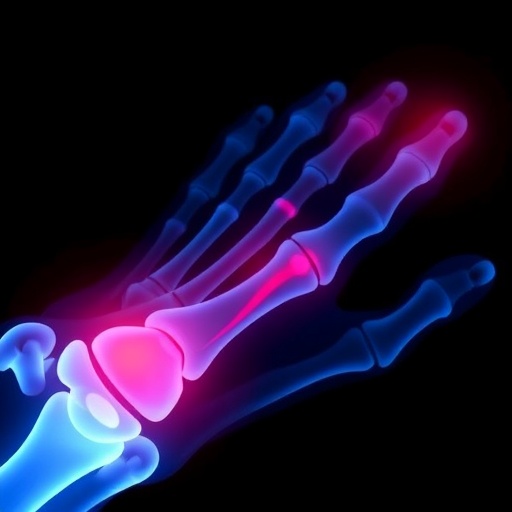In a groundbreaking advancement poised to revolutionize regenerative medicine, researchers have unveiled a novel therapeutic strategy that addresses a critical barrier to bone healing in individuals suffering from hyperglycemia. The study, led by Zhang, Li, Wei, and colleagues, published in Nature Communications, elucidates how the elimination of a deleterious byproduct produced by the enzyme neutrophil PAD4 dramatically restores the capacity of stem cells to facilitate bone regeneration under diabetic conditions. This pioneering discovery offers a promising avenue for countering impaired skeletal repair associated with chronic metabolic disorders such as diabetes.
Hyperglycemia, characterized by persistently elevated blood glucose levels, is notoriously linked to compromised tissue repair mechanisms, especially in bone healing. Patients with diabetes often suffer from delayed fracture healing and poor recovery outcomes, which have been attributed to the multifaceted impairments in cellular functions induced by the hyperglycemic milieu. Despite significant progress in understanding the systemic effects of diabetes, the molecular underpinnings responsible for hampered bone regeneration remained largely elusive until this new research shed light on the critical role of neutrophil-derived factors.
The research team focused on PAD4, short for peptidylarginine deiminase 4, an enzyme predominantly expressed in neutrophils, a type of immune cell integral to the body’s first line of defense. PAD4 catalyzes the conversion of arginine residues into citrulline in various proteins, modulating chromatin structure and affecting neutrophil extracellular trap (NET) formation. While PAD4 activity is vital in innate immunity, its overactivation or dysregulation has been implicated in pathological inflammation and tissue damage.
In hyperglycemic conditions, PAD4 activity leads to the accumulation of a unique byproduct, previously uncharacterized in the context of bone repair. The investigators meticulously identified this PAD4-derived byproduct as a critical inhibitory factor that impairs mesenchymal stem cell (MSC) function. MSCs are progenitor cells capable of differentiating into osteoblasts, the cells responsible for new bone formation. The study’s sophisticated biochemical analyses confirmed that this byproduct disrupts MSC proliferation and differentiation pathways, effectively halting bone regeneration.
The team employed state-of-the-art molecular biology techniques to assess the impact of PAD4 byproduct accumulation on MSC biology. Their findings revealed that the byproduct induces epigenetic modifications in MSCs, altering gene expression profiles essential for osteogenic differentiation. More specifically, transcriptomic profiling illustrated a downregulation of key osteogenic markers such as RUNX2 and OSTERIX in the presence of the PAD4 byproduct, delineating a mechanistic basis for the failure of bone healing observed in hyperglycemic subjects.
To counteract these inhibitory effects, researchers devised a targeted approach that selectively neutralizes the PAD4 byproduct. Using a combination of molecular inhibitors and gene silencing techniques, the study demonstrated that suppression of this byproduct restores MSC function to levels comparable to those observed under normoglycemic conditions. The therapeutic intervention led to the reactivation of osteogenic pathways and substantially accelerated bone regeneration in experimental in vivo models mimicking diabetic bone defects.
The in vivo experiments conducted in hyperglycemic mice provided compelling evidence of the translational potential of this strategy. Treated animals exhibited significantly improved bone density, biomechanical strength, and histological architecture compared to untreated controls. Importantly, the intervention did not compromise immune competency, as neutrophil functions unrelated to PAD4 byproduct formation remained intact, highlighting the specificity and safety of the treatment approach.
Elucidating the nexus between immune cell-derived enzymatic byproducts and stem cell dysfunction represents a paradigm shift in understanding the interplay between metabolic disorders and regenerative failure. Prior research mostly concentrated on systemic inflammation or direct glucose toxicity; however, this study uncovers a new dimension where neutrophil enzymatic activity directly sabotages stem cell-mediated healing. This insight opens the door for therapeutic targeting far beyond bone regeneration, potentially influencing treatments for other chronic healing impairments linked to metabolic diseases.
Furthermore, this discovery challenges the long-held notion that immune cell contributions to tissue healing are predominantly beneficial or merely inflammatory. Instead, the nuanced role of neutrophils and PAD4 signaling underscores a complex regulatory network where immune responses can inadvertently produce factors that impede stem cell function under pathological conditions. Understanding these pathways might facilitate the development of combinatorial treatments harnessing immune modulation alongside stem cell therapy for enhanced clinical outcomes.
The implications of this research extend into the realm of personalized medicine. Patients with diabetes or other hyperglycemic disorders may benefit from tailored interventions targeting PAD4 byproduct accumulation, mitigating the deleterious effects of their metabolic condition on bone healing capacity. Given the rising global prevalence of diabetes, such innovations bear enormous potential to improve quality of life for millions facing poor skeletal repair and associated complications.
Critically, the findings offer a blueprint for the development of pharmacological agents capable of precisely neutralizing the PAD4 byproduct without disrupting the beneficial roles of PAD4 in normal immune defense. The ability to achieve this balance will be paramount to advancing these discoveries into clinical practice. Future directions will undoubtedly involve designing small molecule inhibitors, monoclonal antibodies, or RNA-based therapies customized to impede byproduct formation effectively while preserving systemic immune surveillance.
In conclusion, the pioneering work by Zhang and colleagues marks a significant milestone in regenerative medicine and immunology. By identifying and neutralizing a neutrophil PAD4 byproduct that undermines mesenchymal stem cell-driven bone regeneration in hyperglycemia, they have unveiled a novel therapeutic target for enhancing skeletal repair in complex metabolic diseases. As this research area evolves, it promises to pave the way for innovative treatments restoring regenerative capabilities impaired by chronic pathological conditions, ultimately revolutionizing recovery paradigms for diabetic patients worldwide.
Subject of Research: The study investigates the molecular mechanisms underlying impaired bone regeneration in hyperglycemia, focusing on the role of a PAD4 enzyme byproduct produced by neutrophils and its effect on mesenchymal stem cell function.
Article Title: Elimination of a neutrophil Pad4 byproduct restores stem cell–mediated bone regeneration in hyperglycemia.
Article References:
Zhang, L., Li, J., Wei, X. et al. Elimination of a neutrophil Pad4 byproduct restores stem cell–mediated bone regeneration in hyperglycemia. Nat Commun (2025). https://doi.org/10.1038/s41467-025-66935-x
Image Credits: AI Generated




